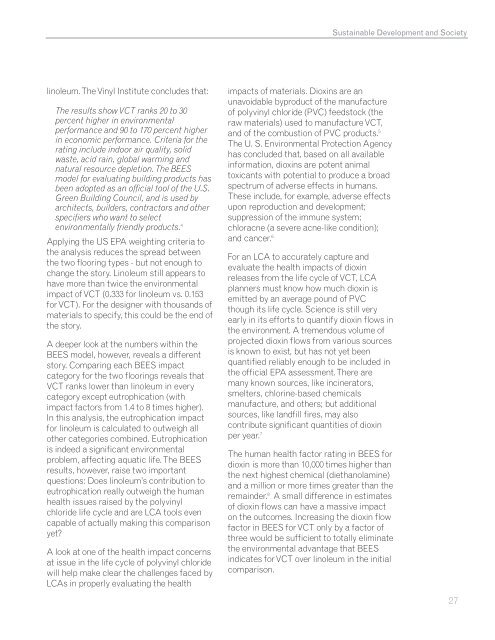Sustainable Development and Society - GSA
Sustainable Development and Society - GSA
Sustainable Development and Society - GSA
You also want an ePaper? Increase the reach of your titles
YUMPU automatically turns print PDFs into web optimized ePapers that Google loves.
<strong>Sustainable</strong> <strong>Development</strong> <strong>and</strong> <strong>Society</strong><br />
linoleum. The Vinyl Institute concludes that:<br />
The results show VCT ranks 20 to 30<br />
percent higher in environmental<br />
performance <strong>and</strong> 90 to 170 percent higher<br />
in economic performance. Criteria for the<br />
rating include indoor air quality, solid<br />
waste, acid rain, global warming <strong>and</strong><br />
natural resource depletion. The BEES<br />
model for evaluating building products has<br />
been adopted as an official tool of the U.S.<br />
Green Building Council, <strong>and</strong> is used by<br />
architects, builders, contractors <strong>and</strong> other<br />
specifiers who want to select<br />
environmentally friendly products. 4<br />
Applying the US EPA weighting criteria to<br />
the analysis reduces the spread between<br />
the two flooring types - but not enough to<br />
change the story. Linoleum still appears to<br />
have more than twice the environmental<br />
impact of VCT (0.333 for linoleum vs. 0.153<br />
for VCT). For the designer with thous<strong>and</strong>s of<br />
materials to specify, this could be the end of<br />
the story.<br />
A deeper look at the numbers within the<br />
BEES model, however, reveals a different<br />
story. Comparing each BEES impact<br />
category for the two floorings reveals that<br />
VCT ranks lower than linoleum in every<br />
category except eutrophication (with<br />
impact factors from 1.4 to 8 times higher).<br />
In this analysis, the eutrophication impact<br />
for linoleum is calculated to outweigh all<br />
other categories combined. Eutrophication<br />
is indeed a significant environmental<br />
problem, affecting aquatic life. The BEES<br />
results, however, raise two important<br />
questions: Does linoleum’s contribution to<br />
eutrophication really outweigh the human<br />
health issues raised by the polyvinyl<br />
chloride life cycle <strong>and</strong> are LCA tools even<br />
capable of actually making this comparison<br />
yet?<br />
A look at one of the health impact concerns<br />
at issue in the life cycle of polyvinyl chloride<br />
will help make clear the challenges faced by<br />
LCAs in properly evaluating the health<br />
impacts of materials. Dioxins are an<br />
unavoidable byproduct of the manufacture<br />
of polyvinyl chloride (PVC) feedstock (the<br />
raw materials) used to manufacture VCT,<br />
<strong>and</strong> of the combustion of PVC products. 5<br />
The U. S. Environmental Protection Agency<br />
has concluded that, based on all available<br />
information, dioxins are potent animal<br />
toxicants with potential to produce a broad<br />
spectrum of adverse effects in humans.<br />
These include, for example, adverse effects<br />
upon reproduction <strong>and</strong> development;<br />
suppression of the immune system;<br />
chloracne (a severe acne-like condition);<br />
<strong>and</strong> cancer. 6<br />
For an LCA to accurately capture <strong>and</strong><br />
evaluate the health impacts of dioxin<br />
releases from the life cycle of VCT, LCA<br />
planners must know how much dioxin is<br />
emitted by an average pound of PVC<br />
though its life cycle. Science is still very<br />
early in its efforts to quantify dioxin flows in<br />
the environment. A tremendous volume of<br />
projected dioxin flows from various sources<br />
is known to exist, but has not yet been<br />
quantified reliably enough to be included in<br />
the official EPA assessment. There are<br />
many known sources, like incinerators,<br />
smelters, chlorine-based chemicals<br />
manufacture, <strong>and</strong> others; but additional<br />
sources, like l<strong>and</strong>fill fires, may also<br />
contribute significant quantities of dioxin<br />
per year. 7<br />
The human health factor rating in BEES for<br />
dioxin is more than 10,000 times higher than<br />
the next highest chemical (diethanolamine)<br />
<strong>and</strong> a million or more times greater than the<br />
remainder. 8 A small difference in estimates<br />
of dioxin flows can have a massive impact<br />
on the outcomes. Increasing the dioxin flow<br />
factor in BEES for VCT only by a factor of<br />
three would be sufficient to totally eliminate<br />
the environmental advantage that BEES<br />
indicates for VCT over linoleum in the initial<br />
comparison.<br />
27

















